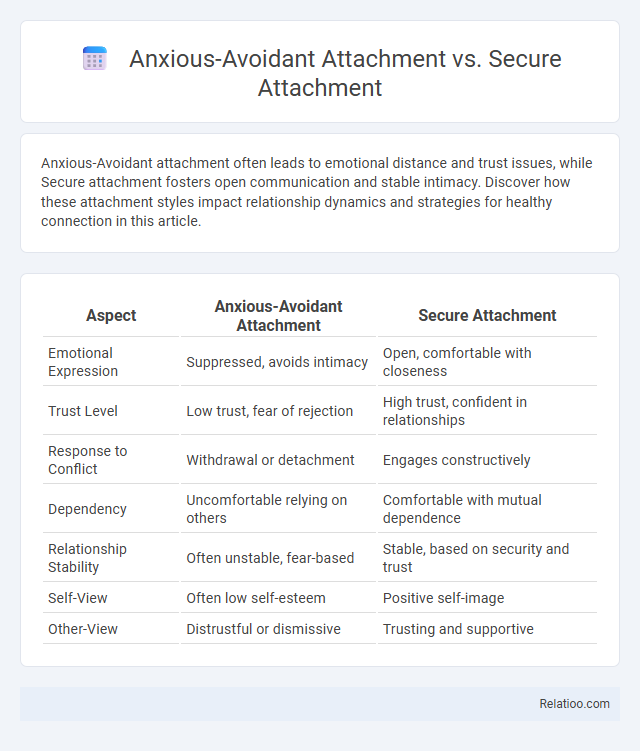Anxious-Avoidant attachment often leads to emotional distance and trust issues, while Secure attachment fosters open communication and stable intimacy. Discover how these attachment styles impact relationship dynamics and strategies for healthy connection in this article.
Table of Comparison
| Aspect | Anxious-Avoidant Attachment | Secure Attachment |
|---|---|---|
| Emotional Expression | Suppressed, avoids intimacy | Open, comfortable with closeness |
| Trust Level | Low trust, fear of rejection | High trust, confident in relationships |
| Response to Conflict | Withdrawal or detachment | Engages constructively |
| Dependency | Uncomfortable relying on others | Comfortable with mutual dependence |
| Relationship Stability | Often unstable, fear-based | Stable, based on security and trust |
| Self-View | Often low self-esteem | Positive self-image |
| Other-View | Distrustful or dismissive | Trusting and supportive |
Understanding Attachment Styles: An Overview
Anxious-avoidant attachment is characterized by discomfort with intimacy and a tendency to suppress emotional needs, often leading to relational conflict due to avoidance of closeness. Secure attachment fosters trust and effective communication, reducing misunderstandings and promoting healthier relationship dynamics. Understanding attachment styles is essential for identifying patterns that contribute to conflict and improving emotional connection in relationships.
What Is Anxious-Avoidant Attachment?
Anxious-avoidant attachment is a bonding style characterized by a reluctance to get too close or rely on others, often resulting from inconsistent caregiving during childhood. Unlike secure attachment, which fosters trust and emotional availability, anxious-avoidant individuals frequently suppress their feelings, leading to emotional distance and increased relational conflict. Understanding your attachment style can help you navigate interpersonal challenges and build healthier relationships.
Key Traits of Secure Attachment
Secure attachment is characterized by emotional openness, trust, and effective communication, enabling individuals to form healthy, stable relationships. Your ability to manage relational conflict with empathy and resilience stems from secure attachment traits such as comfort with intimacy and balanced autonomy. Unlike anxious-avoidant attachment, which involves fear of closeness or abandonment, secure attachment fosters mutual support and constructive conflict resolution.
Childhood Origins of Attachment Styles
Childhood experiences with primary caregivers shape anxious-avoidant and secure attachment styles, profoundly influencing your relational patterns and conflict resolution skills. Anxious-avoidant attachment develops from inconsistent or emotionally unavailable care, leading to difficulty trusting and expressing emotions in adult relationships. Secure attachment stems from responsive and nurturing parenting, fostering healthy communication and resilience in relational conflicts.
Emotional Responses: Anxious-Avoidant vs Secure
Anxious-avoidant attachment is characterized by emotional suppression and discomfort with intimacy, leading to avoidance of closeness during relational conflict, whereas secure attachment involves openness to emotional expression and a willingness to engage in resolving issues. Individuals with anxious-avoidant attachment often respond to conflict with withdrawal and detachment, while securely attached individuals exhibit calmness and seek constructive communication. These contrasting emotional responses significantly impact relationship dynamics and conflict resolution effectiveness.
Impact on Adult Relationships
Anxious-avoidant attachment often leads to difficulties in trusting others and maintaining intimacy, causing frequent relational conflicts and emotional distance in adult relationships. Secure attachment fosters healthy communication, empathy, and resilience, reducing misunderstandings and promoting stable, supportive partnerships. Understanding your attachment style can help improve conflict resolution and deepen connection in your adult relationships.
Communication Patterns and Conflict Resolution
Anxious-avoidant attachment often leads to communication patterns characterized by withdrawal and emotional distance, hindering effective conflict resolution. Secure attachment fosters open, honest dialogue and collaborative problem-solving, allowing conflicts to be addressed constructively and empathetically. Understanding your attachment style can improve relational conflict outcomes by promoting healthier communication and resolution strategies.
Coping Strategies and Self-Regulation
Anxious-avoidant attachment often leads to emotional withdrawal and difficulty trusting others, requiring coping strategies like mindfulness and journaling to enhance self-awareness and emotional regulation. Secure attachment fosters healthy communication and emotional resilience, enabling you to effectively manage relational conflict through active listening and empathetic responses. Developing self-regulation skills such as deep breathing and cognitive reframing supports overcoming attachment-related challenges and promotes harmonious relationships.
Breaking the Cycle: Moving Toward Secure Attachment
Anxious-avoidant attachment often leads to relational conflict due to fears of intimacy and emotional unavailability, creating a cycle of mistrust and avoidance. Breaking this cycle requires recognizing your attachment patterns and actively fostering secure attachment behaviors such as open communication, emotional responsiveness, and consistent support. Shifting toward secure attachment enhances relationship resilience, promoting healthier emotional connections and conflict resolution.
Seeking Help: Therapy and Personal Growth
Anxious-avoidant attachment often leads individuals to resist seeking help due to fears of vulnerability, whereas secure attachment fosters openness to support and collaboration in therapy. In relational conflict, those with secure attachment tend to use effective communication and emotional regulation, promoting personal growth and resolution. Therapy for anxious-avoidant individuals emphasizes building trust and emotional awareness to enhance relationship skills and reduce avoidance behaviors.

Infographic: Anxious-Avoidant Attachment vs Secure Attachment
 relatioo.com
relatioo.com